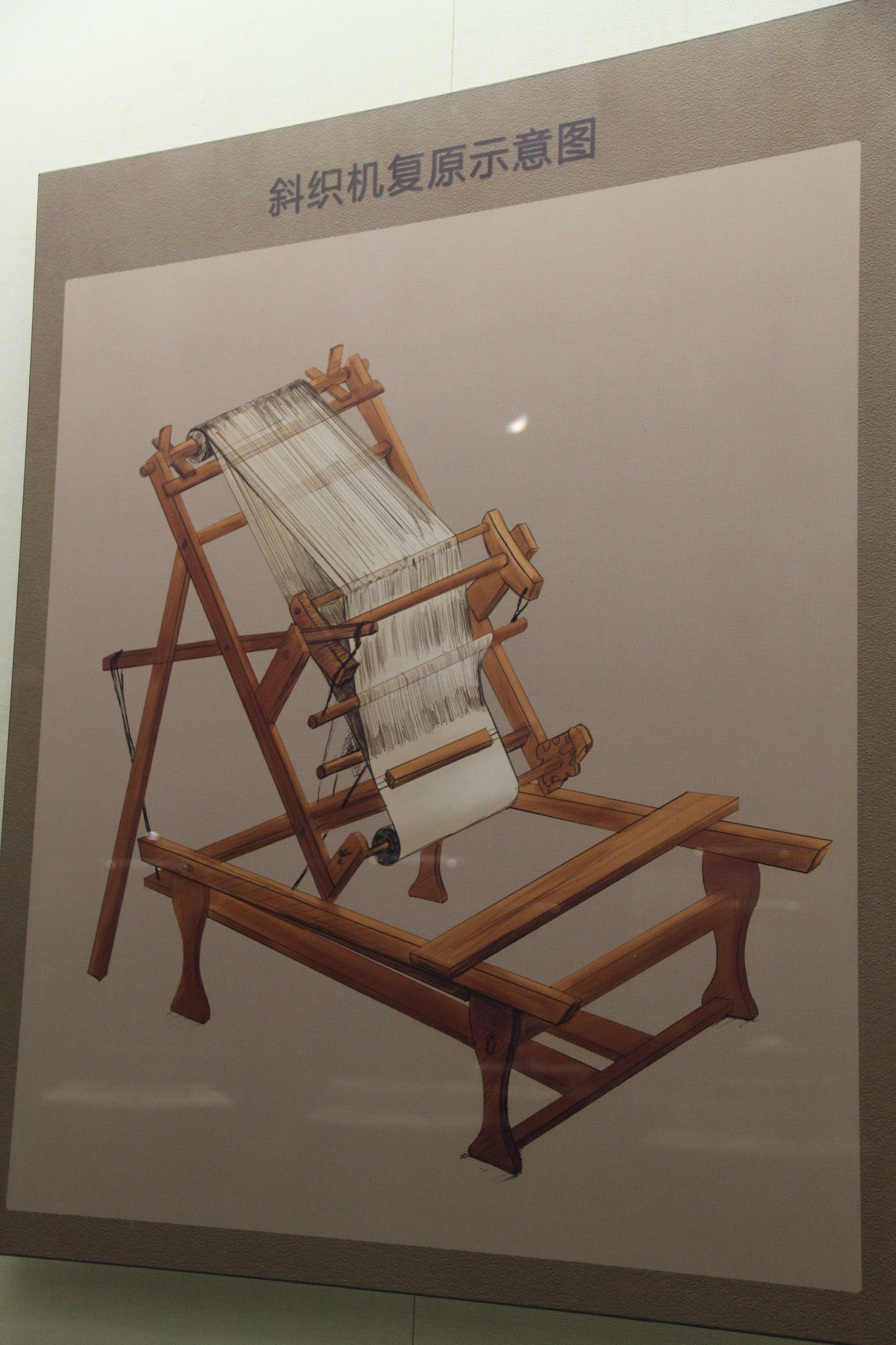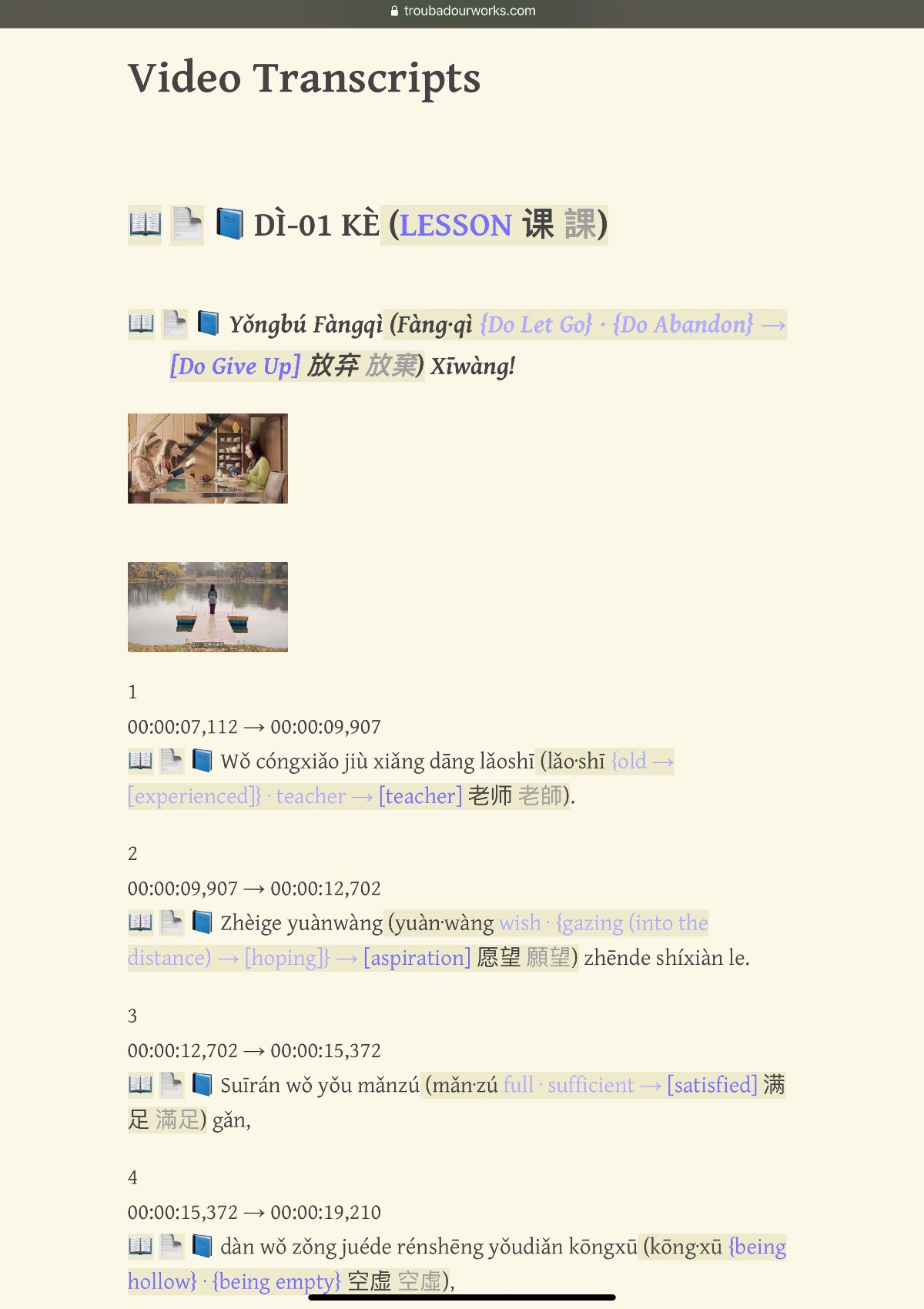lìjīng (lì·jīng {go through}; experience; undergo · {pass through; undergo; experience [→ [bear; endure]]} 历经 歷經) ← Tap/click to show/hide the “flashcard”
One of the unique features of Pīnyīn (Pīn·yīn {Piecing Together} · Sounds → [Pinyin] 拼音) Plus material at this time is Pīnyīn (Pīn·yīn {Piecing Together} · Sounds → [Pinyin] 拼音) Plus video transcripts. These should help us Mandarin field language learners to analyze and understand the Mandarin speech used in the many videos referenced in the Mandarin Enjoy Life Forever! book, for example. This in turn should help us make more effective use of these videos while participating in Mandarin Bible discussions using this book. Hopefully in the future, Pīnyīn (Pīn·yīn {Piecing Together} · Sounds → [Pinyin] 拼音) Plus transcripts will also be available for other publications that use videos.
The Pīnyīn (Pīn·yīn {Piecing Together} · Sounds → [Pinyin] 拼音) Plus transcript for the video used in lesson 04 point 5 of the Mandarin Enjoy Life Forever! book contains the expression “lìjīng (lì·jīng {go through}; experience; undergo · {pass through; undergo; experience [→ [bear; endure]]} 历经 歷經)”, which is this week’s MEotW:
51
00:03:12,542 → 00:03:14,344
📖 📄 📘 Lìjīng (Lì·jīng {having gone through} · {having experienced → [having endured]} 历经 歷經) qiānxīn‐wànkǔ ((qiān·xīn {a thousand} · {(things) being hot in taste → [sufferings]} 千辛)‐(wàn·kǔ {ten thousand} · {(things) being bitter → [hardships]} 万苦 萬苦) → [innumerable trials and tribulations (an interweaving of qiānwàn and xīnkǔ)]),
“Lìjīng (Lì·jīng {go through}; experience; undergo · {pass through; undergo; experience [→ [bear; endure]]} 历经 歷經)” is noteworthy especially because of the meanings of the morphemes that make it up, and because of some of the other expressions that these morphemes are used in.
Mirrors, Histories, and Calendars
First, note that when written in Chinese characters, “lìjīng (lì·jīng {go through}; experience; undergo · {pass through; undergo; experience [→ [bear; endure]]} 历经 歷經)” (历经) is an anadrome (a word which is a different word spelled backwards, its mirror image, if you will) of “jīnglì (jīng·lì {pass/go through}; undergo; experience · {experience (v)} | {passed/gone through; undergone; experienced (thing)} · {experience (n)} → [experience (n)] 经历 經歷)” (经历), which in its verb form seems to mean basically the same thing as “lìjīng (lì·jīng {go through}; experience; undergo · {pass through; undergo; experience [→ [bear; endure]]} 历经 歷經)”. (A “jīnglì (jīng·lì {experienced (thing)} · {experience (n)} → [experience (n)] 经历 經歷)” (noun) is an “experience”, but in contrast, it seems that “lìjīng (lì·jīng {go through}; experience; undergo · {pass through; undergo; experience [→ [bear; endure]]} 历经 歷經)” is not used as a noun.)
Interestingly, the “lì ({pass/go through}; experience; undergo | {experienced (thing[s])} → [experience[s]; record; history] | experienced → [all previous] | calendar 历 歷)” in “lìjīng (lì·jīng {go through}; experience; undergo · {pass through; undergo; experience [→ [bear; endure]]} 历经 歷經)” is also used in “lìshǐ (lì·shǐ {experienced (things) → [history; record[s]} · history → [history; record[s]] 历史 歷史)”, and in “Lìdàizhì Shàng ((Lì·dài·zhì {Experienced → [All Previous]} · {Replacings → [Generations]} · Records 历代志 歷代志) (Shàng Upper 上) → [1 Chronicles])” and “Lìdàizhì Xià ((Lì·dài·zhì {Experienced → [All Previous]} · {Replacings → [Generations]} · Records 历代志 歷代志) (Xià Lower 下) → [2 Chronicles])”.
In its meaning as “calendar”, this “lì ({pass/go through}; experience; undergo | {experienced (thing[s])} → [experience[s]; record; history] | experienced → [all previous] | calendar 历 歷)” also appears in, for example, “gōnglì (gōng·lì {common → [Gregorian]} · calendar 公历 公曆)”, meaning “Gregorian calendar”. Connected to this, the Referenced Theo. Expressions (RTE) resource has an interesting entry on “Gōnglì (Gōng·lì {Common → [Gregorian]} · Calendar 公历 公曆) Jìyuán (Jì·yuán Era · Unit → [Era] 纪元 紀元)”:
common era; wtl09 index sync. Lit. “Gregorian-calendar beginning-of-era”. Often abbreviated to 公元 gōngyuán (see 2001 NWT’s table of books). Note that in Chinese you put 公元 and 公元前 BEFORE the year number, not after it as in English. E.g. 公元29年 = 29C.E.
Warp, Weft, and Scriptures
The “jīng ({pass through; undergo; experience [→ [bear; endure]]} | scripture; canon; classics | constant; regular | {warp (textiles)} [→ [longitude]] 经 經)” in “lìjīng (lì·jīng {go through}; experience; undergo · {pass through; undergo; experience [→ [bear; endure]]} 历经 歷經)” also appears in some noteworthy expressions. Since it can mean “pass through; undergo; experience”, it’s no surprise that “jīng ({pass through; undergo; experience [→ [bear; endure]]} | scripture; canon; classics | constant; regular | {warp (textiles)} [→ [longitude]] 经 經)” appears in “jīngguò (jīng·guò {pass through} · pass; cross [→ [go through; undergo]] 经过 經過)” and in “jīngyàn (jīng·yàn {having passed through} · testing → [experience] 经验 經驗)”. (Jīngyàn (Jīng·yàn {having passed through} · testing → [experience] 经验 經驗) (experience) is what one gains after going through jīnglì (jīng·lì {experienced (things)} · experiences → [experiences] 经历 經歷) (experiences), although an experience can also be called a jīngyàn (jīng·yàn {having passed through} · testing → [experience] 经验 經驗).)
“Jīng ({pass through; undergo; experience [→ [bear; endure]]} | scripture; canon; classics | constant; regular | {warp (textiles)} [→ [longitude]] 经 經)” also has a meaning—possibly its root meaning—of “warp”, a term from weaving. As summarized by Wikipedia:
Warp and weft are the two basic components used in weaving to turn thread or yarn into fabric. The lengthwise or longitudinal warp yarns are held stationary in tension on a frame or loom while the transverse weft (sometimes woof) is drawn through and inserted over and under the warp.[source]
Thus, in the picture below, the warp is the threads that are mounted on the loom, that go up and down, and the weft is the threads that go left and right.

![]() Some rights reserved by Gary Lee Todd, Ph.D.
Some rights reserved by Gary Lee Todd, Ph.D.
Note that the quote above from Wikipedia calls the warp the longitudinal threads. Mandarin takes this comparison to the place of actually using “jīng ({pass through; undergo; experience [→ [bear; endure]]} | scripture; canon; classics | constant; regular | {warp (textiles)} [→ [longitude]] 经 經)” to also mean “longitude”, as used in geography. So, “jīngwěi (jīng·wěi {warp (textiles) [→ [longitude]]} · {weft; woof [→ [latitude]]} [→ [logical planning; plan; orderliness | situation; state of affairs | manage; administer]] 经纬 經緯)”, which means “warp and weft” in weaving, also means “longitude and latitude” in geography.
Of course, as students of the Bible, we Mandarin field language learners should also be aware that the “jīng ({pass through; undergo; experience [→ [bear; endure]]} | scripture; canon; classics | constant; regular | {warp (textiles)} [→ [longitude]] 经 經)” in “lìjīng (lì·jīng {go through}; experience; undergo · {pass through; undergo; experience [→ [bear; endure]]} 历经 歷經)” can mean “scripture”. So, it appears in expressions that we see and hear a lot, like “Shèngjīng (Shèng·jīng (the) Holy · Scriptures → [the Bible] 圣经 聖經)”, “jīngwén (jīng·wén scripture · writing → [scripture] 经文 經文)”, and jīngjuàn (jīng·juàn scripture · volume [→ [Bible book]] 经卷 經卷).
For convenience:
The direct link for the current generation Pīnyīn (Pīn·yīn {Piecing Together of} · Sounds → [Pinyin] 拼音) Plus resource for the Enjoy Life Forever! book is:
The short link for Chinese field language-learning links for the Enjoy Life Forever! book is:
More Pīnyīn (Pīn·yīn {Piecing Together of} · Sounds → [Pinyin] 拼音) and Pīnyīn (Pīn·yīn {Piecing Together of} · Sounds → [Pinyin] 拼音) Plus web material based on the Mandarin Enjoy Life Forever! book will be made available in the Pīnyīn (Pīn·yīn {Piecing Together of} · Sounds → [Pinyin] 拼音) Plus web resource as time allows.
